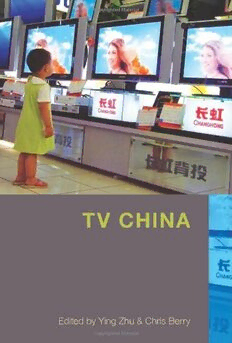
TV China PDF
Preview TV China
Film & Media TV institutions, programming, Z h Asia and audiences in Greater China u and the Chinese diaspora & B e r r “Fills an important gap in both Chinese studies y and media studies.” Lisa Rofel, University of California, Santa Cruz “There is nothing currently comparable in English, t and quite possibly in any language.” v John Downing, Southern Illinois University C h If radio and film were the emblematic Contributors are Chris Berry, Joseph M. i n media of the Maoist era, television has Chan, Hsiu-Chuang Deppman, Junhao rapidly established itself as the medium Hong, Amy Lee, Xinyu Lu, Yanmei Lü, a of the “marketized” China and in the Karin Gwinn Wilkins, Cindy Hing-Yuk diaspora. In less than two decades, Wong, Janice Hua Xu, Haiqing Yu, television has become the dominant Tongdao Zhang, Ying Zhu, and William medium across the Chinese cultural Zou. world. TV China is the first anthology in English on this phenomenon. Covering Ying Zhu is Associate Professor of t v China the People’s Republic, Hong Kong, Cinema Studies in the Department of Taiwan, and the Chinese diaspora, these Media Culture at the College of Staten twelve original essays introduce and Island, City University of New York. analyze the Chinese television industry, its programming, the policies shaping it, Chris Berry is Professor of Film and and its audiences. Television Studies in the Department of Media and Communication at Goldsmiths, University of London. INDIANA Cover illustration University Press AP/Wide World Photos Bloomington & Indianapolis IND Edited by Ying Zhu & Chris Berry http://iupress.indiana.edu IA N 1-800-842-6796 A TVChinaMech.indd 1 11/13/08 10:30:53 AM TV China T V China Edited by Ying Zhu & Chris Berry Indiana University Press Bloomington & Indianapolis This book is a publication of tional Standard for Information Sciences— Permanence of Paper for Printed Library Indiana University Press Materials, ANSI Z39.48-1984. 601 North Morton Street Bloomington, IN 47404-3797 USA Manufactured in the United States of America http://iupress.indiana.edu Library of Congress Cataloging-in- Telephone orders 800-842-6796 Publication Data Fax orders 812-855-7931 Orders by e-mail [email protected] TV China / edited by Ying Zhu and Chris Berry. © 2009 by Indiana University Press p. cm. All rights reserved Includes index. ISBN 978-0-253-35257-6 (cloth : alk. paper) No part of this book may be reproduced or — ISBN 978-0-253-22026-4 (pbk. : alk. utilized in any form or by any means, elec- paper) 1. Television broadcasting—China. tronic or mechanical, including photocopy- I. Zhu, Ying, date II. Berry, Chris, date ing and recording, or by any information PN1992.3.C6Z49 2008 storage and retrieval system, without permis- 384.550951—dc22 sion in writing from the publisher. The Asso- ciation of American University Presses’ Reso- 2008028560 lution on Permissions constitutes the only exception to this prohibition. 1 2 3 4 5 14 13 12 11 10 09 The paper used in this publication meets the minimum requirements of American Na- Contents Introduction ∙ Ying Zhu & Chris Berry ∙ 1 Part 1 ∙ Institution 1 Toward Television Regionalization in Greater China and Beyond ∙ Joseph M. Chan ∙ 15 2 CCTV in the Reform Years: A New Model for China’s Television? ∙ Junhao Hong, Yanmei Lü, & William Zou ∙ 40 3 Hong Kong Television: Same as It Ever Was? ∙ Karin Gwinn Wilkins ∙ 56 Part 2 ∙ Programming 4 Shanghai Television’s Documentary Channel: Chinese Television as Public Space ∙ Chris Berry ∙ 71 5 Made in Taiwan: An Analysis of Meteor Garden as an East Asian Idol Drama ∙ Hsiu-Chuang Deppman ∙ 90 6 Ritual, Television, and State Ideology: Rereading CCTV’s 2006 Spring Festival Gala ∙ Xinyu Lu ∙ 111 vi · Contents Part 3 ∙ Reception 7 Mediation Journalism in Chinese Television: Double-Time Narrations of SARS ∙ Haiqing Yu ∙ 129 8 Building a Chinese “Middle Class”: Consumer Education and Identity Construction in Television Land ∙ Janice Hua Xu ∙ 150 9 Chinese Television Audience Research ∙ Tongdao Zhang ∙ 168 Part 4 ∙ Going Global 10 Hong Kong Television and the Making of New Diasporic Imaginaries ∙ Amy Lee ∙ 183 11 Globalizing Television: Chinese Satellite Television outside Greater China ∙ Cindy Hing-Yuk Wong ∙ 201 12 Transnational Circulation of Chinese-Language Television Dramas ∙ Ying Zhu ∙ 221 Appendix: Relevant Milestone Events in the Development of Chinese Television ∙ 243 List of Contributors ∙ 249 Index ∙ 251 TV China Introduction Ying Zhu & Chris Berry If radio and film were the emblematic media of the Maoist era, television has rapidly established itself as the medium of “marketized” China. Just twenty years ago, television sets were few and far between, and mostly installed in public places. Now almost every mainland Chinese household has a television set, and television is the main source of news and entertainment for most Chinese. Furthermore, television has pioneered the marketization of the media that has occurred over the last decade. Although television stations are still government-owned, they gener- ate more revenue in taxes for central government than they receive from it, and they also dominate national spending on advertising. Television has also become the dominant medium in every Chinese-speak- ing territory outside the mainland: in Hong Kong, Taiwan, Malaysia, and Singa- pore, and in Chinese communities around the world. The advent of satellite broadcasting, falling trade barriers, and other features of globalization have led to vastly increased circulation of materials among Chinese-speaking territories. The days when diasporic Chinese had never seen a China Central Television news item from Beijing, or mainland audiences had never seen a TVB drama from Hong Kong, are long gone. While academic research and writing about Chinese television has in- creased in recent years, there is still significantly less material available in English on Chinese television than there is on Chinese literature or film, for example, and coverage remains sporadic and patchy. This anthology responds to this lack, and to the changes in the nature of Chinese-language broadcast- ing itself.
